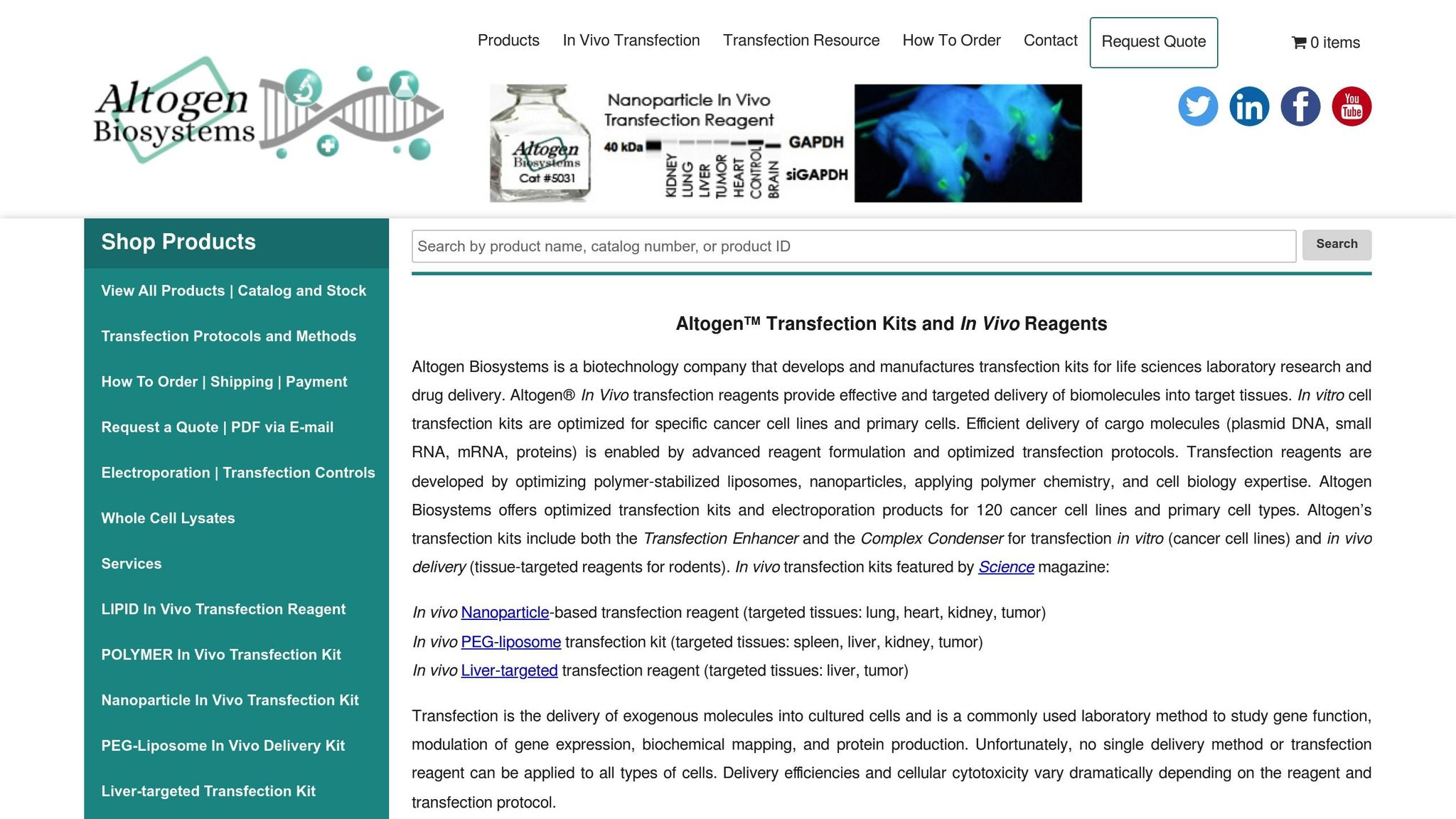Nanoparticles are tiny particles that can cross biological barriers, deliver drugs precisely, and even protect enzymes like telomerase. Telomerase is crucial for maintaining telomeres, the "caps" on chromosomes that shorten as cells divide, leading to aging. By boosting telomerase activity, nanoparticles may help slow aging and support cell renewal. Here's how they work:
- Gold Nanoparticles (AuNPs): Protect telomerase from oxidative damage, slowing telomere shortening.
- Magnetic Nanoparticles: Bind to telomerase and enhance its activity at telomeres; also used to measure telomerase activity.
- Lipid Nanoparticles (LNPs): Deliver telomerase mRNA into cells, increasing enzyme production.
Benefits of Nanoparticles in Telomerase Research:
- Precise Delivery: Targets specific cells, minimizing risks.
- Dual Functionality: Enables both treatment and diagnostic capabilities.
- Anti-Aging Potential: Supports telomere maintenance for healthier cells.
While promising, researchers are addressing safety concerns like cancer risks by refining targeted delivery methods and improving nanoparticle designs. These advancements could revolutionize aging treatments and cancer research.
Altogen Biosystems In Vitro BJ Transfection Tutorial

How Nanoparticles Activate Telomerase
Nanoparticles, tiny particles much smaller than a strand of human hair, use several methods to influence telomerase activity in cells. By working through three primary pathways, they directly boost telomerase levels, paving the way for enhanced cellular renewal.
Delivering Telomerase mRNA
Lipid nanoparticles (LNPs) play a pivotal role in delivering telomerase mRNA to cells. They act as protective carriers, shielding the mRNA from degradation during its journey into the cell. Once inside, the LNPs release the mRNA, allowing the cell's ribosomes to translate it into the telomerase enzyme. Here's how the process unfolds:
| Stage | Function | Outcome |
|---|---|---|
| Protection & Entry | LNPs shield mRNA and facilitate cell uptake | Ensures efficient delivery |
| Release | LNPs dissolve, freeing mRNA | mRNA becomes available |
| Production | Ribosomes translate mRNA into telomerase | Boosts enzyme production |
DNA Sequence Binding
Magnetic nanoparticles, when paired with telomeric repeats (TTAGGG), bind to telomerase. This interaction enhances the enzyme's recruitment and activity directly at the telomere sites, improving its efficiency in maintaining telomere length.
Protection from Oxidative Damage
Gold nanoparticles (AuNPs) help protect telomerase by neutralizing reactive oxygen species (ROS), which can damage the enzyme and telomeres. In recent in vitro studies, AuNPs were shown to increase telomerase activity and slow telomere shortening in human fibroblast cells [3]. This protective mechanism ensures the enzyme remains functional and telomere integrity is preserved.
Current Uses in Research and Treatment
Nanoparticles are playing a key role in advancing both the measurement of telomerase activity and potential therapeutic applications.
Measuring Telomerase Activity
Scientists have developed nanoparticle-based systems to precisely measure telomerase levels. A dual nanosensor system, for instance, can simultaneously assess telomerase protein levels and enzyme activity across various cell types, providing valuable data for research and clinical use [1].
Here’s how these measurements are carried out:
| Measurement Type | Nanoparticle Used | Detection Method | Time Required |
|---|---|---|---|
| Activity Detection | Magnetic particles with synthetic oligonucleotides | Telomerase activity nanosensor | 4 hours |
| Protein Level Detection | Magnetic particles with anti-hTERT antibodies | Telomerase protein nanosensor | 4 hours |
| Combined Analysis | Dual nanosensor system | Clinical MR scanners | Same-day results |
These methods are incredibly sensitive, capable of detecting telomerase activity in samples containing as few as 1 to 1,000 cells [4]. This level of precision opens up new possibilities for exploring how nanoparticles can aid in cell renewal treatments.
Cell Renewal Treatments
Gold nanoparticles (AuNPs) have shown exciting potential in recent studies. Research published in 2023 revealed that AuNPs could boost telomerase activity and slow the shortening of telomeres in human fibroblasts [3]. By enhancing the uptake and stability of oligonucleotides, these nanoparticles allow for targeted modulation of telomerase activity [2].
The goal of these treatments is to activate telomerase production using specially designed nanoparticles. Integrated nanosensor systems, capable of rapid analysis via clinical MR scanners, further support this approach by providing quick and accurate measurements of telomerase activity [1]. However, while these advancements are promising, researchers remain cautious due to the potential risks, such as uncontrolled cell growth.
As nanoparticle design and delivery methods continue to evolve, efforts are focused on refining these technologies to ensure both effectiveness and safety.
sbb-itb-4f17e23
Limitations and Next Steps
Cancer Risk Management
One of the major concerns with telomerase activation is that, if left unchecked, it could encourage tumor growth. To address this, researchers are focusing on strategies like targeted delivery using cell-specific markers, detecting oxidative stress, and implementing regular screening protocols. These measures, when combined with advancements in nanoparticle delivery, aim to make anti-aging treatments safer and more reliable.
| Safety Measure | Implementation Method | Risk Mitigation |
|---|---|---|
| Targeted Delivery | Cell-specific surface markers | Activates telomerase only in healthy, aging cells |
| Environmental Triggers | Oxidative stress detection | Releases payload in non-cancerous environments |
| Monitoring Protocol | Regular screening | Early detection of potential malignancies |
Cell-Specific Delivery
Fine-tuning cell-specific binding remains a critical focus. Recent innovations have significantly improved this process, allowing functionalized nanoparticles to better recognize and attach to specific cell types. For example, breakthroughs include antibody-conjugated magnetic nanoparticles, DNA sequence-specific binding, and peptide-functionalized surface modifications. These advancements not only enhance precision but also reduce off-target effects, making treatments more effective.
New Nanoparticle Designs
Building on the progress in cell-specific delivery, the latest nanoparticle designs are pushing the boundaries of what’s possible. These designs emphasize features like improved biocompatibility, controlled release mechanisms, and real-time tracking capabilities, all of which make telomerase modulation more efficient and safer to monitor.
| Design Feature | Function | Benefit |
|---|---|---|
| Oligonucleotide Coating | Delivers genetic material | Provides combined therapy and telomerase control |
| Magnetic Properties | Enables real-time tracking | Facilitates simultaneous treatment and imaging |
| Surface Chemistry | Boosts stability | Enhances survival in the bloodstream and uptake |
While these innovations hold promise, researchers stress the importance of rigorous clinical trials to ensure both safety and long-term effectiveness. Current efforts are also directed at improving nanoparticle stability in the bloodstream and minimizing immune system reactions to these treatments [1][2].
Conclusion
Nanoparticles in Age Management
Nanoparticles are emerging as a promising tool for targeted telomerase delivery in age management. Early research suggests that these engineered particles could help provide precise telomere support, enhancing cellular health. This approach brings exciting possibilities for advancing how we address aging, offering practical strategies for anti-aging solutions - an area championed by MASI Longevity Science.
MASI Longevity Science's Approach

MASI Longevity Science builds on these advancements by combining cutting-edge research with expertise from institutions like the Mayo Clinic and Harvard Medical School. The result? High-quality anti-aging supplements designed to address key factors in the aging process.
"MASI is the only manufacturer to our knowledge crafting NMN, Spermidine, Fisetin and Resveratrol supplements in Germany using premium, German-sourced raw materials. Our boutique production ensures exceptional quality, and subscribing guarantees availability of your essential supplements." – MASI Longevity Science
MASI's commitment to quality is evident in every step of their process. Their supplements are manufactured in Germany using carefully sourced raw materials and undergo independent testing in Switzerland, ensuring both safety and effectiveness.
Here’s a look at their product lineup:
| Supplement | Dosage | Primary Function |
|---|---|---|
| Premium NMN | 1,000 mg | Supports cellular energy |
| Premium Resveratrol | 500 mg | Provides antioxidant protection |
| Premium Spermidine | 3 mg | Encourages cellular renewal |
| Premium Fisetin | 500 mg | Promotes cellular health |
FAQs
How do nanoparticles interact with telomerase to promote healthy telomere lengthening?
Nanoparticles are crafted to interact directly with telomerase, the enzyme that plays a crucial role in maintaining and extending telomeres - the protective ends of chromosomes. These tiny particles can deliver specific compounds or activate certain biochemical pathways to boost telomerase activity, potentially aiding in telomere lengthening and promoting overall cellular health.
What makes this approach so intriguing is its precision. Nanoparticles are designed to target telomerase specifically, minimizing interference with other cellular functions. The exact mechanisms depend on the type of nanoparticles and the biological pathways they are engineered to affect. For those delving into the field of longevity science, understanding how these interactions work opens up exciting possibilities for advancing cellular renewal and anti-aging therapies.
What are the risks of using nanoparticles to activate telomerase, and how are scientists addressing them?
The application of nanoparticles to activate telomerase shows exciting potential in medical research, but it’s not without its challenges. A major concern is the risk of nanoparticles unintentionally building up in healthy tissues, which could lead to toxicity or trigger inflammation. Another significant issue is the possibility that improper activation of telomerase might result in uncontrolled cell growth - a known factor in cancer development.
To tackle these risks, scientists are working on creating nanoparticles that are both highly targeted and biodegradable. This ensures they interact only with specific cells or tissues, reducing unintended effects. Additionally, rigorous testing and strict safety protocols are being developed to enhance the reliability and safety of these cutting-edge treatments.
How do nanoparticles like gold, magnetic, and lipid types interact with telomerase to support telomere lengthening?
Nanoparticles - like gold, magnetic, and lipid-based varieties - are showing promise in boosting telomerase activity and helping maintain telomeres. These tiny particles can either serve as delivery vehicles, bringing therapeutic agents straight to cells, or as agents that modify the biological environment to support telomerase function. For instance, gold nanoparticles are valued for their stability and their ability to bind with biomolecules, while lipid nanoparticles excel at safely delivering genetic material or drugs to specific cells.
While the exact interactions among these nanoparticles in this context still need more investigation, combining them might amplify telomerase activation by taking advantage of their distinct features. This approach could lead to exciting advancements in anti-aging research and cellular health, complementing the progress being made in longevity-focused technologies and supplements.




